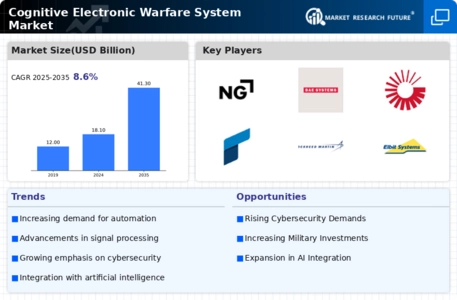The Cognitive Electronic Warfare System Market is currently characterized by a dynamic competitive landscape, driven by rapid technological advancements and increasing defense budgets across various nations. Key players such as Northrop Grumman (US), Raytheon Technologies (US), and BAE Systems (GB) are at the forefront, leveraging their extensive R&D capabilities to innovate and enhance their product offerings. Northrop Grumman (US) focuses on integrating artificial intelligence into its systems, aiming to improve decision-making processes in electronic warfare. Meanwhile, Raytheon Technologies (US) emphasizes strategic partnerships and collaborations to expand its market reach and enhance its technological capabilities. BAE Systems (GB) is actively pursuing mergers and acquisitions to bolster its portfolio, indicating a trend towards consolidation in the market. Collectively, these strategies contribute to a competitive environment that is increasingly centered around technological superiority and strategic alliances.
In terms of business tactics, companies are increasingly localizing manufacturing and optimizing supply chains to enhance operational efficiency and reduce costs. The market appears moderately fragmented, with several key players exerting significant influence. This structure allows for a diverse range of offerings, yet the collective strength of major companies shapes the competitive dynamics, pushing smaller firms to innovate or seek partnerships to remain viable.
In August 2025, Northrop Grumman (US) announced a strategic partnership with a leading AI firm to develop next-generation cognitive electronic warfare systems. This collaboration is poised to enhance the capabilities of their systems, allowing for more adaptive and responsive electronic warfare solutions. The integration of AI is likely to provide a competitive edge, enabling faster and more accurate threat detection and response.
In September 2025, Raytheon Technologies (US) unveiled a new suite of electronic warfare tools designed for multi-domain operations. This launch reflects the company's commitment to addressing the evolving needs of modern warfare, particularly in joint operations across air, land, and sea. The introduction of these tools is expected to strengthen Raytheon's position in the market, as it aligns with the increasing demand for integrated solutions that can operate seamlessly across various platforms.
In July 2025, BAE Systems (GB) completed the acquisition of a smaller tech firm specializing in advanced signal processing technologies. This acquisition is strategically significant as it enhances BAE's capabilities in developing sophisticated electronic warfare systems. By integrating these advanced technologies, BAE Systems is likely to improve its competitive stance, offering more robust solutions to its clients.
As of October 2025, the Cognitive Electronic Warfare System Market is witnessing trends such as digitalization, AI integration, and a growing emphasis on sustainability. Strategic alliances are becoming increasingly vital, as companies recognize the need to pool resources and expertise to stay competitive. Looking ahead, the competitive differentiation in this market is expected to evolve, with a shift from price-based competition towards innovation, technological advancement, and supply chain reliability. Companies that can effectively leverage these trends will likely emerge as leaders in the cognitive electronic warfare domain.

















Leave a Comment